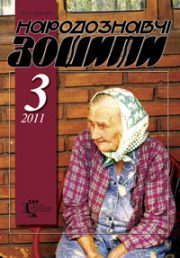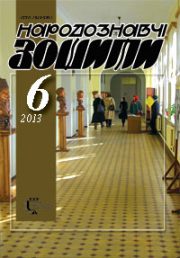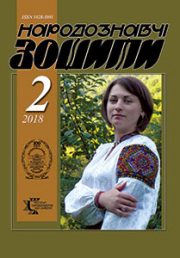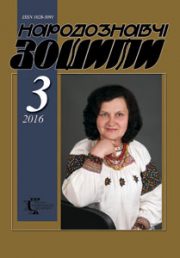The Ethnology Notebooks. 2021. № 5 (161), 1114—1122
UDK [[398.3:392]:316.422](477.85/.87)”19/20″
DOI https://doi.org/10.15407/nz2021.05.1114
HERUS Lyudmyla
- ORCID ID: https://orcid.org/0000-0002-5931-3816
- Сandidate of Аrts (Ph. D), Senior Researcher
- Institute of Ethnology of the National Academy
- of Sciences of Ukraine
- Department of Folk Art
- 15, Svobody Avenue, 79000, Lviv, Ukraine,
- Contacts: e-mail: ludmilagerus@gmail.com
Abstract. Introduction. Today, when the majority of Ukrainian population lives in an urban, highly industrial society, and traditional culture under the pressure of globalization suffers constant significant losses, the study of its well-preserved elements and related viewpoints becomes especially relevant. The elucidation of the worldview and practical significance of the ritual bread of Ukrainians, including the «kolach», in present time is due to the need to establish the reasons for the transformation of the tradition and predict its directions in the future.
Article purpose consists of the features of the functioning of one of the most distinctive attributes of the traditional rituals of Ukrainians — the «kolach» on the example of the Bukovyna part of the Hutsul region. The research was based on the author`s field materials [;], as well as professional literature about rituals.
Methods. The research was conducted based on the ethnographic information gathering during expeditions by observation and interview methods as well as a comparative-historical method.
Results. The functional and ethical-aesthetic features of the ritual using of «kolach» in the Bukovyna part of the Hutsul region are considered in the paper, the reasons for their transformation are clarified, the ways of its visualization are paid attention. Important in the process of adaptation of traditional principles of life, both of the individual and of the society, is recognized as the constant modernization of their transmission technology.
The ritual nature of the «kolach» is expressed by its well-established plastic solution: round (annular, solid) and oblong shape; the relief of the surface, which is obtained by forming the «kolach» and applying to its surface separately sculpted from the dough phytomorphic, ornithomorphic and abstract plastic elements, mostly on the principle of mirror symmetry; using mainly on wedding «kolaches» the specially made elements of floral origin and artificial, deliberately made, which decorate the «kolach» after its baking.
Based on analysis of the current state of the problem, we can summarize that a process of structural changes in traditional rituals and the gradual extinction of ritual elements, caused by secularization, ideological factors and modernization of society that took place during the XX century.
Keywords: Bukovyna part of the Hutsul region, «kolach», bread, ritual, tradition, worldviews, transformation, globalization, heritage, preservation.
Received 27.10.2021
REFERENCES
- Archive of the Institute of Ethnology of the National Academy of Sciences of Ukraine. F. 1. Op. 2. Act. 581b. Field materials of Неrus L. Ritual bread (Vyzhnytskyi, Putylskyi districts of Chernivtsi region, Verkhovyna district of Ivano-Frankivsk region. 2008) [in Ukrainian].
- Herus, L. (2013). Ornithomorphic bread of Ukrainians (plasticity, functions, semantics in the context of the Slavic tradition). Traditions and current state of culture and arts. (Part 5, pp. 36—43). Minsk [in Russian].
- Herus, L. (2006). The Ukrainian Korovai: form, types and stylistic peculiarities of plastic elements. Art Studies ’06: sciences. zb. (Pp. 36—47) Lviv [in Ukrainian].
- Herus, L. (2009). The Ukrainian Easter bread Paska (function, form, plastic). Bulletin of the Kharkiv State Academy of Design and Arts. Art history. Architecture, 15, 18—25) [in Ukrainian].
- Herus, L. (2008). Ornamentations of Ukrainian Korovai – Bread. Types, Artistic Expressivenes, Symbolism. Art Studies’06: sciences. zb. (Pp. 63—75) Lviv [in Ukrainian].
- Kajndl’, R.F. (2000). Hutsuls: their lives, customs and folk traditions. Chernivtsi [in Ukrainian].
- Shukhevych, V. (1904). Hutsulschyna. Materialy z ukra ins’ko rus’koi etnolohii (Vol. VII, pp. 1—256) [in Ukrainian].
- Rusnak, J. (2020). Sacred meaning of wedding dishes in wedding rituals of bukovynians. Scientific Bulletin of Chernivtsi National University. Slavic philology (Issue 697—699, pp. 319—324) [in Ukrainian].







